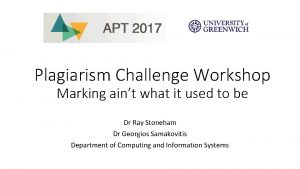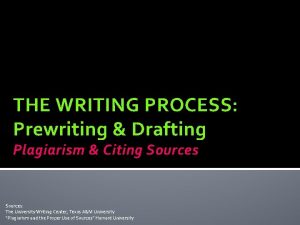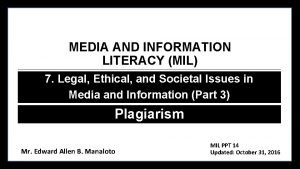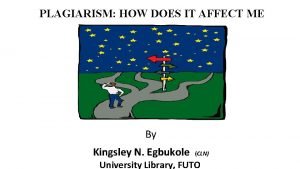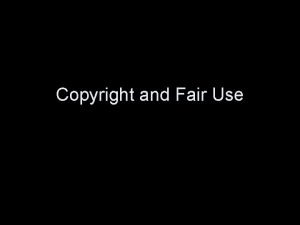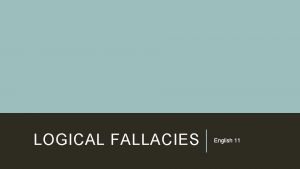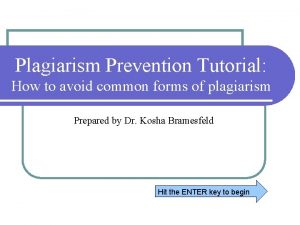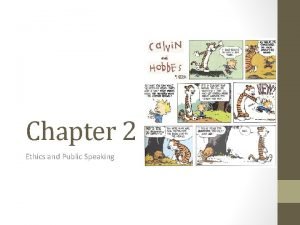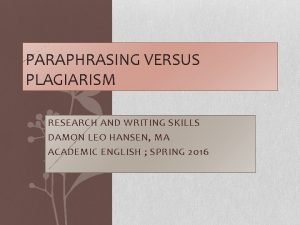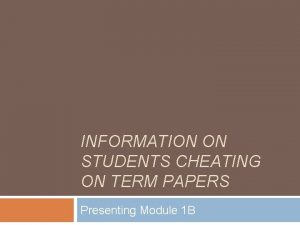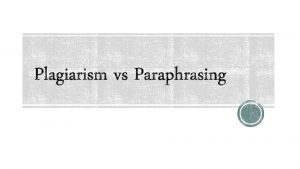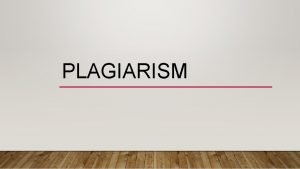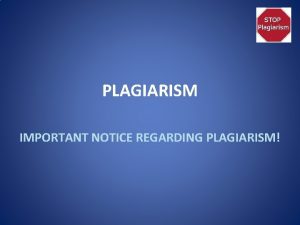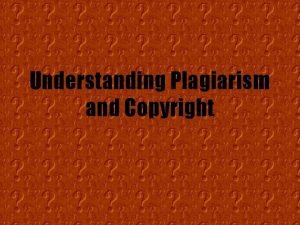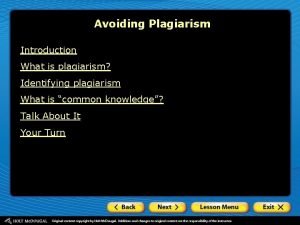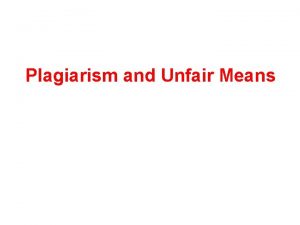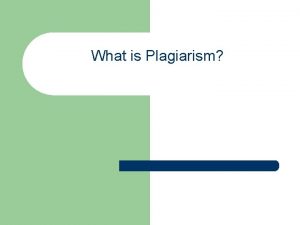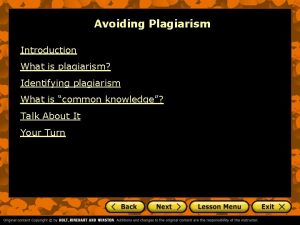What is Plagiarism What is plagiarism According to















- Slides: 15

What is Plagiarism?

What is plagiarism? According to the Merriam-Webster Online Dictionary, plagiarism, or to “plagiarize”means: 1. to steal and pass off the ideas or words of another as one's own 2. use another's production without crediting the source 3. to commit literary theft 4. present as new and original an idea or product derived from an existing source 1 1. "Plagiarism. " Merriam-Webster. 2006. Merriam-Webster, Inc. . 1 Aug 2006 <http: //www. merriamwebster. com/dictionary/plagiarism>.

Further Explanation • Plagiarism comes from the Latin word “kidnapping”. Instead of stealing an actual person, you steal a person’s ideas and/or writing!2 • Anytime you use another person’s ideas or words without giving proper credit to that person, you are committing PLAGIARISM! 2. "What is Plagiarism? . " Kidshealth. 2006. 31 Jul 2006 <http: //kidshealth. org/kid/feeling/school/plagiarism. html>.

Have YOU ever plagiarized? Ask yourself these questions… • Have I ever cut and pasted information from a web page into my own document? • Have I ever gotten information out of an article and put it into my own paper by rewording the sentence? • Have I ever added audio clips from the web into a Power. Point presentation? • Have I ever used an image from the web on a cover page or in a presentation?

If you answered YES to any of those questions and did NOT cite your source, then you have committed PLAGIARISM! AND those are just some of the ways students plagiarize.

If proper credit is not given, the following actions are examples of plagiarism: • using a direct quotation word-for-word • submitting rephrased ideas of another person • submitting, as your own, papers or sections of texts accessed from the Internet • copying material from an encyclopedia, dictionary, or other source • using data that you did not derive by yourself • using non-textual material such as musical or artistic copyrighted works, compositions, or choreography

If you use any of the following resources, you must give credit to the creator in order to avoid plagiarism: • • • photographs software letters emails sound recordings • web pages • books • poems • • • articles plays movies choreography paintings graphics video games songs … and more

What is wrong with plagiarism? If you plagiarize, then you are also doing the following: 1. You are STEALING someone else’s words and ideas 2. You are LYING because you are implying that the words and ideas are your own 3. You are CHEATING by using someone else’s work as your own 3 3. Harris, Robert. "Anti-Plagiarism Strategies for Research Papers. " Virtual Salt 17 November 2004:

Plagiarism has consequences… If you plagiarize, you may be punished in the following ways: Failure of assignment Failure of class Expulsion Legal action may take place resulting in heavy fines

How do I avoid plagiarism? CITE YOUR SOURCE “Most cases of plagiarism can be avoided, however, by citing sources. Simply acknowledging that certain material has been borrowed, and providing your audience with the information to find that source, is usually enough to prevent plagiarism. ” 4 4. "What is Plagiarism? . " Turnitin. com. 31 Jul 2006 <http: //www. turnitin. com/researc_site/e_what_is_plagiarism. html>.

So remember… Plagiarism is when you use ideas, language, or work of another without giving proper credit, a citation, or reference to the original author, text, or source. Always give proper credit when using the words, work, or ideas of others! PLAGIARISM

Works Cited Harris, Robert. "Anti-Plagiarism Strategies for Research Papers. " Virtual Salt 17 November 2004. "Plagiarism. " Merriam-Webster. 2006. Merriam-Webster, Inc. . 1 Aug 2006 <http: //www. merriamwebster. com/dictionary/plagiarism>. "What is Plagiarism? . " Kidshealth. 2006. 31 Jul 2006 <http: //kidshealth. org/kid/feeling/school/plagiarism. html>. "What is Plagiarism? . " Turnitin. com. 31 Jul 2006 <http: //www. turnitin. com/researc_site/e_what_is_plagiari sm. html>.

Acknowledgements Special thanks to the Instructional Technology and Library Media Staff of Washington County, MD for the use of their Library Media Lesson Plans and this Power. Point Presentation

6 Steps to Effective Paraphrasing 1. Reread the original passage until you understand its full meaning. 2. Set the original aside, and write your paraphrase on a note card. 3. Jot down a few words below your paraphrase to remind you later how you envision using this material. At the top of the note card, write a key word or phrase to indicate the subject of your paraphrase.

6 Steps to Effective Paraphrasing 4. Check your rendition with the original to make sure that your version accurately expresses all the essential information in a new form. 5. Use quotation marks to identify any unique term or phraseology you have borrowed exactly from the source. 6. Record the source (including the page) on your note card so that you can credit it easily if you decide to incorporate the material into your paper.
 Plagiarism means
Plagiarism means Ukessay.com plagiarism
Ukessay.com plagiarism Young lex plagiarism
Young lex plagiarism Direct plagiarism definition
Direct plagiarism definition The forgotten footnote plagiarism
The forgotten footnote plagiarism Hxxp www scanmyessay com
Hxxp www scanmyessay com Ghostbusters plagiarism
Ghostbusters plagiarism Hasty generalization
Hasty generalization 5 types of plagiarism
5 types of plagiarism What is incremental plagiarism
What is incremental plagiarism Plagiarism pronunciation
Plagiarism pronunciation Plagiarism merriam webster
Plagiarism merriam webster Doc cop plagiarism
Doc cop plagiarism Difference between plagiarism and paraphrasing
Difference between plagiarism and paraphrasing Plagiarism checker purdue
Plagiarism checker purdue Plagiarism
Plagiarism

